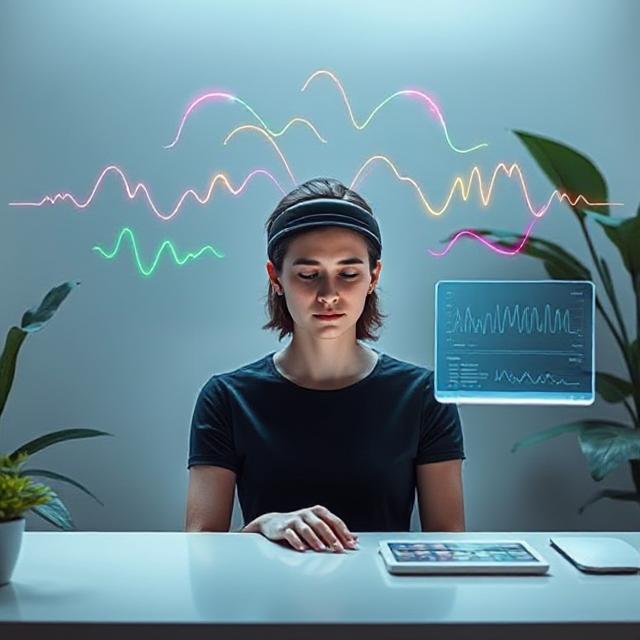
Table of Contents
Tracking Your Brainwaves with Consumer EEG Tools
TL;DR
Consumer EEG devices like Muse, NeuroSky, and OpenBCI let you visualize brainwave activity in real time. They’re not as precise as medical-grade EEGs but can still train focus, improve meditation, and optimize sleep. Learn what each brainwave means, how to interpret the data, and how to avoid common pitfalls.
What Is EEG, and Why Use It at Home?
Electroencephalography (EEG) measures the brain’s electrical activity through sensors on the scalp. Traditionally used in hospitals and research, it’s now available in wearable, affordable form factors—EEG headbands you can use at home.
Consumer EEG tools let you:
- Track changes in mental state during meditation or work
- Get real-time feedback on relaxation, stress, or attention
- Improve sleep by identifying patterns or disruptions
- Train focus or calm through guided neurofeedback sessions
What Brainwaves Can You See with Consumer EEG?
Most commercial EEGs focus on five main frequency bands:
| Wave | Frequency (Hz) | Mental State |
|---|---|---|
| Delta | 0.5–4 | Deep sleep, healing |
| Theta | 4–8 | Daydreaming, intuition, light meditation |
| Alpha | 8–12 | Calm alertness, relaxation, creativity |
| Beta | 13–30 | Focused attention, stress, problem-solving |
| Gamma | 30–100+ | Insight, sensory integration, unity states |
Typical EEG Readouts:
- Bar graphs for each frequency band
- Real-time charts of mental state
- Session summaries showing % time in each wave state
- Some apps include brain maps or heat signatures of activity
Best Consumer EEG Devices (2025 Overview)
| Device | Features | Best For | Price |
|---|---|---|---|
| Muse 2/3 | Meditation tracking, EEG + heart/breath/motion | Mindfulness & focus | $250–400 |
| NeuroSky MindWave | Basic EEG, attention + meditation scores | Beginners & students | $100–150 |
| OpenBCI | Open-source, raw EEG access, research-level | Developers, tinkerers | $500+ |
| Emotiv Insight | 5-channel EEG with emotional tracking | Sleep, stress, performance | $350–400 |
| FocusCalm | Simple focus/relax neurofeedback system | Daily productivity & calm | $150–250 |
What Can You Actually Do with This Data?
1. Train Focus or Calm with Neurofeedback
Many EEG headbands offer guided sessions where:
- You hear sound cues or visual feedback based on your brainwaves
- The system rewards “desired states” (e.g., more alpha or less beta)
- You begin learning what internal states feel like, improving self-awareness
Example: When you’re calm, ocean waves become quieter. If your mind wanders, they roar—training you to recognize the difference.
2. Monitor Meditation Progress
Track:
- How long you stay in alpha or theta states
- Your recovery time when distracted
- Whether your sessions are shallow or deep
Apps like Muse and Insight Timer gamify this process, helping you build a routine.
3. Optimize Sleep and Rest Cycles
Track shifts in delta and theta activity to:
- Improve sleep onset timing
- Detect disturbances or brain hyperactivity
- Measure post-nap rejuvenation
Some devices pair with HRV (heart rate variability) and sleep stage data for full-spectrum biofeedback.
Limitations of Consumer EEG Tools
- Electrode Quality
- Consumer devices use dry electrodes—less sensitive than gel-based lab systems
- You may lose signal if hair interferes or contact slips
- Noise & Artifact Interference
- Movement, blinking, and muscle tension distort EEG data
- Learning proper posture and stillness is key
- Low Spatial Resolution
- Most headbands only read forehead (prefrontal) activity
- You miss signals from deeper or rear brain regions
- Interpretation Can Be Tricky
- High beta doesn’t always mean stress—could be deep focus
- Gamma readings are often noisy or device-dependent
- Not Diagnostic
- These devices are not medical tools
- They’re best for trends and self-awareness, not diagnoses
Tips for Accurate Brainwave Tracking
- Stay still: avoid jaw clenching or blinking during sessions
- Use a mirror to ensure electrodes contact the skin well
- Track at the same time daily to control for circadian shifts
- Pair EEG with journaling to record internal experiences
- Focus on trends, not single readings
How to Use EEG Data for Brainwave Optimization
| Goal | Track These Waves | Use These Techniques |
|---|---|---|
| Relaxation | Increase alpha, lower beta | Breathwork, music, guided imagery |
| Focus | Boost mid-beta, reduce low-beta | Pomodoro tasks, clear goals |
| Creativity | Increase alpha-theta crossover | Walking, open-ended play |
| Spiritual States | Boost gamma, theta coupling | Stillness, visualization |
| Sleep Prep | Increase theta/delta | Yoga nidra, body scan meditation |
Future of Personal EEG
Expect next-gen wearables with:
- More channels (full head coverage)
- Dry polymer sensors with better signal-to-noise ratios
- AI-based signal cleaning for artifact removal
- Integration with AR/VR for immersive neurofeedback
- Combined EEG + fNIRS for better insight into brain oxygenation
Final Thoughts: Know Thy Brain
Tracking your brainwaves can deepen your self-awareness and reveal how states like stress, boredom, and bliss manifest electrically. While not perfect, these tools offer a rare window into your living mind.
Use them to become not just more productive—but more conscious.
“Don’t just change your brain—watch it change, and learn.”
